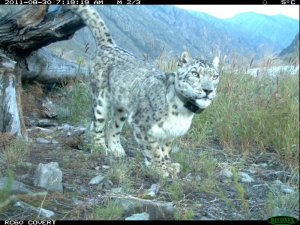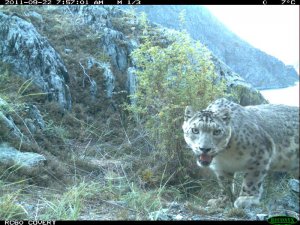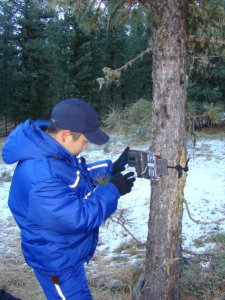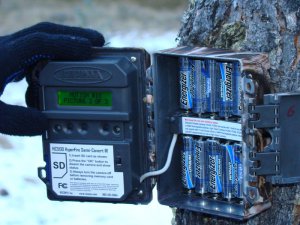 In the Sayans, not far from the well-known mountain pass, an expedition started studying the habitat of the rarest and most mysterious large cat in the world - snow leopard. Before the start, expedition members gave some new, unique photos of the irbis to the Russian Geographic Society.
In the Sayans, not far from the well-known mountain pass, an expedition started studying the habitat of the rarest and most mysterious large cat in the world - snow leopard. Before the start, expedition members gave some new, unique photos of the irbis to the Russian Geographic Society.
The snow leopard, or irbis, is the only permanent resident of the high mountain zone among the large cats. It personifies the majestic, mysterious and brutal world of Central Asia mountain ranges. Russia is the possessor of the northernmost population grouping of this practically unstudied species, which inhabits the mountain ranges of South Siberia, Altai, Sayans and Tuva. The irbis population her, according to various evaluations, numbers about 70-150 individuals. Three to five individuals live in various districts, more rarely nine to twelve. The habitat of snow leopard in Russia comprises 2% of the contemporary range of the whole world, and the irbis population is also about 2% of the world total snow leopard population.
Irbis is adapted to life in hard climatic conditions; it is seen in sub-alpine and alpine belts at altitudes of 700 to 1500 meters above sea level. The optimal habitat conditions are cliffs and a shallow snow cover. The body length is 100-130 centimeters, with tail length of 80-100 centimeters and body mass of 40-50 kilograms.
The chief prey of snow leopards are Siberian mountain goat, but if it is not available irbis may feed on argali, maral deer, roe deer, musk deer, wild boar, northern reindeer, Arctic hares and partridges.
Snow leopards migrate, with the longest routes of over 600 kilometers. The daily travel is about 30 kilometers. Their way of life is solitary, and the life span in nature is no more than 20 years. The snow leopard is listed in the first amendment of the Convention about trade in rare and disappearing species SITES, in the Red list of International nature protection association and in the Red Book of Russia.
The project in study of irbis under the patronage of Russian geographic Society began in 2010, and on 15 April 2011, the chairman of the Curator board of RGO, V.V. Putin presented a grant for its realization to the state nature e preserve "Khakasskiy".
 In the framework of this grant, a search of the large territory of habitat of the most secretive cat of the world was performed, photo-traps were set up, and reports of irbis sightings collected earlier were verified. On the basis of these data, the most probable corridors of irbis migration between the centers of its habitations were determined on territories of Khakassia, Krasnoyarsk Krai, Tuva and Altai.
In the framework of this grant, a search of the large territory of habitat of the most secretive cat of the world was performed, photo-traps were set up, and reports of irbis sightings collected earlier were verified. On the basis of these data, the most probable corridors of irbis migration between the centers of its habitations were determined on territories of Khakassia, Krasnoyarsk Krai, Tuva and Altai.
"One of the mysteries of snow leopards is in that we don't know where they go and where they come from, - scientific worker of "Sayansko-Shushenskiy" preserve, S. V. Istomov tells us. ( Sayano-Shushenskiy is a partner of Khakasskiy - the animals live in both of them. Sergei Vasilyevich is one of the best snow leopard specialists, who has been studying irbis for many years.) - We have this female who has three kittens every year, as registered by photo-traps. The kittens prosper and grow up, then they leave in unknown direction. Periodically the photo-traps document the appearance of males new in our territory. Where they come from, we don't know either so far…"
Before photo-traps became available, and the possibility of using them in the preserve came only last year, scientists identified the leopards by the tracks they left. Of course, this method was not especially accurate. Now, thanks to photographs, the scientists know their leopards "by face" and can determine how many strangers come into their realm.
 "Istomov walks the same trails with the leopards, the photo-traps that he sets up register the greatest numbers of animals, yet he has never seen one in person, - says Irina Sannikova, the head of RGO department in Khakassia. - We joke among ourselves that our irbises have this kind of entertainment: they sit in a hide-away and watch Sergei Vasilyevich sneaking around. It is certain that they have seen him!"
"Istomov walks the same trails with the leopards, the photo-traps that he sets up register the greatest numbers of animals, yet he has never seen one in person, - says Irina Sannikova, the head of RGO department in Khakassia. - We joke among ourselves that our irbises have this kind of entertainment: they sit in a hide-away and watch Sergei Vasilyevich sneaking around. It is certain that they have seen him!"
The expedition members gave a press conference in Abakan before they set out, for the media, where they explained the tasks of the project. In conclusion, Irina Sannikova noted that the expedition activities in mountain taiga environment of the Altai-Sayan region is colossally dangerous, because there is no communication and no roads in the mountains. "it is very important that in those cases there are people nearby who can give the necessary help," - with these words, the head of the RGO department presented letters of gratitude and presents to members of Emergency Services who were present at the meeting.
General-Major Andrei Firsov, chief of Russian GU Emergency Services of Khakassia, did not stay far behind, and in his turn he praised "Khakasskiy": "for the second year forests have been burning in Russia, including in nature preserves. And they burn in such a way that emergency situations arise, with the Emergency Services have to be brought in to liquidate them. This means that the fire control in nature preserves is not carried out properly. There is no such problem in Khakassia. We know that in the "Khakasskiy" preserve, a lot of time and strength goes into fire prevention. We are grateful for all the work!"
To cover as much leopard habitat territory as possible, members of the expedition started out from two places simultaneously: from "Khakasskiy" and from "Ubsunur depression" in Tuva. By joint effort, the two groups should study 18 probable trails of irbis migration, and to walk about 250 km in aggregate. The planned  date when the two teams are to meet is on 3-5 November by Pozarym lake. Because the research workers have gone to places where a car cannot go and a helicopter can't land, their main means of transport are horses.
date when the two teams are to meet is on 3-5 November by Pozarym lake. Because the research workers have gone to places where a car cannot go and a helicopter can't land, their main means of transport are horses.
To distribute the cargo evenly, the expedition members have taken everything necessary from their backpacks and transferred it into special bags which will be towed by local stocky small horses. The only equipment that they will carry themselves are the photo-traps. "These are high-speed digital cameras with passive infrared motion detectors, and during darkness, special infrared lights go on, - "Khakasskiy" staff scientist, Pavel Kulemeyev tells us. - During the daylight hours, the images are in color, 3.1 MP, and at night in monochrome. The minimal interval between snapshots is 1 second, with up to 10 shots in sequence. The trap can save up to 5000 shots, and it runs on 6 batteries. The snapshot has information on date, time, lunar phase, air temperature. The camera is fully protected from atmospheric precipitation." The photo-traps are located on so-called "urine points" - as a rule, these are rocks or trees marked by the leopards.
 Day before the start of the expedition, its members gave the RGO some unique photos taken about a week before. Thanks to this, readers of our site can see what irbis looks like in its natural environment.
Day before the start of the expedition, its members gave the RGO some unique photos taken about a week before. Thanks to this, readers of our site can see what irbis looks like in its natural environment.
One of the main goals of the "On the trail of the snow leopard" is organization of state natural sanctuary "Pozarym" the territory of which is located between the areas of "Khakasskiy" and "Sayano-Shushenskiy".
Because of its upper trophic level in ecosystems, snow leopard serves as a kind of "poster child" for the protection of all animal world of Central Asia high mountain regions. Correspondingly, protection of viable irbis populations is necessarily associated with effective protection of its habitat as a whole, the organizers of the expedition are convinced.

